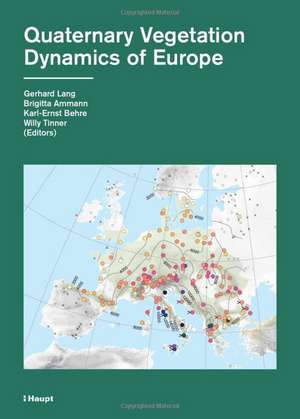Quaternary Vegetation Dynamics of Europe
Editat de Gerhard Lang, Brigitta Ammann, Karl-Ernst Behre, Willy Tinneren Limba Engleză Hardback – 12 iun 2023
2,6 Millionen Jahre im Überblick.
Für Studierende, Forschende und die Praxis.
Dieses Buch, in englischer Sprache verfasst, gibt einen faszinierenden und einmaligen Überblick über die wechselvolle Geschichte der europäischen Pflanzenbedeckung der letzten 2,6 Millionen Jahre, die durch zahlreiche Kalt- und Warmzeiten gekennzeichnet ist. Dabei wird der Zeitraum der letzten 20.000 Jahre (Späteiszeit und Holozän) ausführlich dargestellt, mit besonderem Schwerpunkt auf der Vegetationsdynamik Europas, der Geschichte ausgewählter Gehölze, der Entwicklung von Seen und Mooren und der Entstehung europäischer Kulturlandschaften unter dem Einfluss des Menschen.
Damit liegt auch erstmals eine detaillierte Synthese der vielen Erkenntnisse zur europäischen Vegetationsdynamik vor.
Das Buch richtet sich in erster Linie an Studierende, Forschende und Praktiker:innen in Pflanzenökologie, Paläoökologie, Paläoklimatologie, Forstwirtschaft, Quartärwissenschaften, Klimawissenschaften, Biogeographie, Geographie und Archäologie.
Preț: 716.27 lei
Preț vechi: 930.22 lei
-23% Nou
137.12€ • 142.53$ • 113.69£
Carte disponibilă
Livrare economică 13-18 ianuarie 25
Livrare express 02-08 ianuarie 25 pentru 71.90 lei
Specificații
ISBN-10: 3258082146
Pagini: 688
Ilustrații: 287 Abbildungen, 45 Tabellen
Dimensiuni: 202 x 270 x 57 mm
Greutate: 2.59 kg
Editura: Haupt Verlag AG
Descriere
Based on palaeoecological studies by many authors, this book gives an overview of the changing history of the European plant cover during the past 2.6 million years, characterized by numerous cold and warm periods.
The period of the last 20 000 years (from the Last Glacial Maximum to the present) is presented in detail, with special emphasis on the vegetation dynamics of Europe, the history of selected woody plants, the development of lakes and bogs and the emergence of European cultural landscapes under the influence of humans over thousands of years. In the analysis of the glacial and interglacial periods, the focus is on the different vegetation developments and the progressive impoverishment of the European flora.
Further important topics are the spatio-temporal patterns and causes of long-term vegetation changes, the legacies of disturbances and land use on vegetation composition, the role of palaeoecology in nature conservation and its contribution to ecology and environmental sciences.
In addition to recent research results, the book provides an overview of the main palaeoecological research methods. It concludes with a summary of the history of palaeoecology and Quaternary botany. For the first time, a detailed synthesis is presented of the many findings on European vegetation dynamics, which are complex and increasingly difficult to summarize. Numerous figures and tables, many of them original, accompany the text.
The bibliography includes over 3000 publications. This book is primarily intended for students, researchers and practitioners in plant ecology, palaeoecology, palaeoclimatology, forestry, agronomy, Quaternary sciences, climate sciences, biogeography, geography and archaeology.





